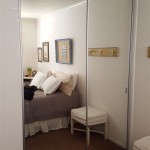Height of Bathroom Mirror: Achieving Optimal Functionality and Aesthetics
The height at which a bathroom mirror is installed is a critical factor in achieving both optimal functionality and aesthetic appeal within the space. Proper mirror placement ensures comfortable use for all household members while contributing to the overall design coherence of the bathroom. Deviation from standard guidelines can result in discomfort, visual imbalance, and a less-than-satisfactory bathroom experience. Therefore, careful consideration should be given to the various factors that influence the ideal height for a bathroom mirror.
This article will explore the key considerations for determining the correct height of a bathroom mirror, covering standard height recommendations, adjustments based on user height, the influence of mirror size and shape, and the impact of surrounding bathroom fixtures. By understanding these aspects, individuals can confidently select the appropriate mirror height for their specific needs and bathroom configuration.
Understanding Standard Bathroom Mirror Height Recommendations
The most common recommendation for bathroom mirror height is to position the center of the mirror approximately 60 to 65 inches from the finished floor. This range is generally considered to be a comfortable height for most adults, allowing them to see their reflection clearly without having to strain or stoop. This standardized measurement aims to accommodate a wide range of heights, offering a practical starting point for installation.
However, it's important to acknowledge that this is merely a guideline and not a strict rule. Individual circumstances can necessitate deviations from this standard. Factors such as the average height of the household members, the intended use of the mirror (e.g., shaving, applying makeup), and the overall design aesthetic of the bathroom should all be taken into account when determining the final mirror height.
In situations where multiple users with significant height differences share the bathroom, it may be advantageous to prioritize the needs of the primary user or to find a compromise that accommodates both individuals reasonably well. Alternatively, adjustable mirrors or multiple mirrors at different heights could be considered to cater to the specific requirements of each user. The placement of the mirror should also consider the placement of the vanity and sink.
Adjusting Mirror Height Based on User Height and Needs
While the standard recommendation provides a useful starting point, customizing the mirror height based on the height and needs of the users is essential for optimal functionality. If the primary users of the bathroom are significantly shorter or taller than average, adjustments to the standard height will be necessary to ensure comfortable use.
For shorter individuals, lowering the mirror may be required to ensure that they can see their reflection clearly without having to stand on tiptoes or strain their necks. Conversely, for taller individuals, raising the mirror will prevent them from having to bend over or crouch down to see themselves. A simple method for determining the ideal height is to have each user stand in front of the intended mirror location and mark the point at which their eyes are level. The center of the mirror should then be positioned at or slightly above this eye level mark.
Furthermore, the intended use of the mirror should also be considered. For example, if the mirror is primarily used for applying makeup, it may be beneficial to position it slightly lower to allow for a closer and more detailed view. Conversely, if the mirror is primarily used for shaving, a slightly higher position may be preferable to provide a better view of the neck and jawline. The depth of the vanity can also affect where the user stands to use the mirror affecting the height decision.
The Influence of Mirror Size, Shape, and Bathroom Fixtures
The size and shape of the mirror, as well as the placement of surrounding bathroom fixtures, can also influence the optimal mirror height. Larger mirrors, for example, may require a lower mounting position to ensure that the entire reflection is visible without straining the user's neck. Conversely, smaller mirrors may benefit from a slightly higher position to maximize their visibility and impact.
The shape of the mirror can also play a role. Tall, narrow mirrors may be positioned higher to emphasize their verticality and create a sense of height in the bathroom. Wide, horizontal mirrors may be positioned lower to emphasize their width and create a sense of spaciousness. The overall design aesthetic of the bathroom should also be considered when selecting the mirror shape and height. Rectangular mirrors are generally versatile, but round or oval mirrors can add a softer touch to the space. Unique shapes can become a focal point.
The placement of surrounding bathroom fixtures, such as the vanity, sink, and lighting, can also affect the optimal mirror height. The bottom edge of the mirror should typically be positioned a few inches above the top of the backsplash or countertop to prevent water from splashing onto the mirror and to create a visually balanced appearance. The positioning of the mirror should also take into account the placement of the lighting fixtures. Ideally, the lighting should be positioned to illuminate the face evenly without creating harsh shadows or glare. This may necessitate adjusting the mirror height to accommodate the lighting.
Consideration should also be given to the space between the bottom of the mirror and the faucet. A general guideline is to leave at least 4-8 inches to prevent water from splashing on the mirror and to make cleaning easier. If a vessel sink (a sink that sits on top of the counter) is used, the mirror may need to be mounted higher to compensate for the increased height of the sink and faucet combination.
Framed mirrors, typically, need the bottom of the frame placed 4-8 inches above the sink backsplash. Frameless mirrors can be mounted closer to the backsplash. However, it's crucial to seal the bottom edge properly to prevent water damage.
When installing multiple mirrors side by side, it’s important to ensure that the top and bottom edges are aligned to create a cohesive and visually appealing look. The space between the mirrors should be consistent and proportionate to the size of the mirrors and the overall dimensions of the bathroom.
In powder rooms or smaller bathrooms, a larger mirror can create the illusion of more space. Consider extending the mirror across a significant portion of the wall to reflect more light and visually expand the room. This can often mean pushing height considerations higher, prioritizing width for the illusion of expanded space.
Ultimately, determining the ideal height for a bathroom mirror requires careful consideration of several factors, including the standard recommendations, the height and needs of the users, the size and shape of the mirror, and the placement of surrounding bathroom fixtures. By taking these factors into account, individuals can select the mirror height that best suits their specific needs and creates a functional and aesthetically pleasing bathroom space.
The style of the bathroom can also influence the ideal height. Traditional bathrooms might benefit from mirrors mounted at a slightly higher position to complement the ornate design elements. Modern bathrooms often feature minimalist designs, which might call for lower-mounted mirrors to maintain clean lines and a streamlined aesthetic. Consider architectural details like ceiling height and trim when determining mirror placement.
The presence of other design features, such as wainscoting or tile work, can also impact the perceived height and placement of the mirror. The mirror's position relative to these elements should be carefully considered to create a visually harmonious and balanced design. Integrating the mirror seamlessly into the existing architectural framework will enhance the overall aesthetic appeal of the bathroom.
Finally, it is recommended to take the time to test different mirror heights by temporarily holding the mirror in place before permanently installing it. This allows users to visually assess the height and make any adjustments as needed to ensure optimal comfort and functionality. Taking this extra step can prevent costly mistakes and ensure that the mirror is perfectly positioned to meet the needs of all users.

Bathroom Mirror Size Calculator

Standard Bathroom Vanity Mirror Height Google Search Measurements Sizes Plan

Bathroom Mirror Size Calculator

Standard Height For Bathroom Mirror Dimensions Vessel Sink Vanity Sizes

All Bathroom Dimensions You Need To Know

What Is The Standard Height Of A Bathroom Vanity 2024 Guide

How To Hang A Wash Basin Mirror Step By Guide Accent

Vanity Height Buscar Con Google Bathroom Measurements Dimensions Floor Plans

Bathroom Vanities Buy Vanity Furniture Cabinets Rgm Distribution

Bathroom Sconces Where Should They Go Designed








